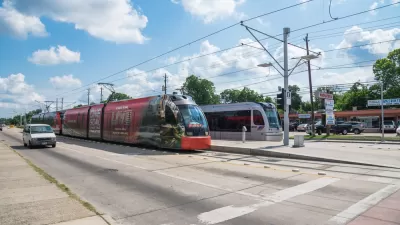City officials in Houston are set to consider plans to incentivize broad pedestrian walkways near existing and planned light rail stations within the city.
"The city's urban transit corridors ordinance, which it began developing in June 2006, is expected to be considered by the City Council in July. It would offer incentives for developers in six light rail corridors to include a 15-foot "pedestrian realm" with broad, unobstructed sidewalks and other features intended to create appealing, walkable environments.
The new development created under this ordinance will become part of the daily lives of more than 160,000 people the Metropolitan Transit Authority expects to be riding its trains by 2030. Within the next five years, the agency plans to add five new rail lines to the Main Street line it opened on Jan. 1, 2004.
The impact of the ordinance will depend on developers' willingness to comply with its mostly voluntary standards. Those who agree to create the pedestrian zone will automatically be exempt from rules requiring buildings to be set back a specified distance from the street, giving them more space to build revenue-generating offices, homes or shops."
Thanks to Reconnecting America
FULL STORY: Houston's hope: Easier to catch a train

Planetizen Federal Action Tracker
A weekly monitor of how Trump’s orders and actions are impacting planners and planning in America.

Maui's Vacation Rental Debate Turns Ugly
Verbal attacks, misinformation campaigns and fistfights plague a high-stakes debate to convert thousands of vacation rentals into long-term housing.

Restaurant Patios Were a Pandemic Win — Why Were They so Hard to Keep?
Social distancing requirements and changes in travel patterns prompted cities to pilot new uses for street and sidewalk space. Then it got complicated.

In California Battle of Housing vs. Environment, Housing Just Won
A new state law significantly limits the power of CEQA, an environmental review law that served as a powerful tool for blocking new development.

Boulder Eliminates Parking Minimums Citywide
Officials estimate the cost of building a single underground parking space at up to $100,000.

Orange County, Florida Adopts Largest US “Sprawl Repair” Code
The ‘Orange Code’ seeks to rectify decades of sprawl-inducing, car-oriented development.
Urban Design for Planners 1: Software Tools
This six-course series explores essential urban design concepts using open source software and equips planners with the tools they need to participate fully in the urban design process.
Planning for Universal Design
Learn the tools for implementing Universal Design in planning regulations.
Heyer Gruel & Associates PA
JM Goldson LLC
Custer County Colorado
City of Camden Redevelopment Agency
City of Astoria
Transportation Research & Education Center (TREC) at Portland State University
Jefferson Parish Government
Camden Redevelopment Agency
City of Claremont





























